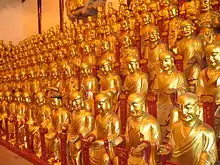Sāvakabuddha
Sāvakabuddha is a Pali term used rarely in Theravada Buddhism to refer to an enlightened disciple of a Buddha. Such enlightened disciples obtained nibbāṇa by hearing the dhamma as initially taught by a sammasambuddha. A sāvakabuddha is distinguished from a sammasambuddha and a paccekabuddha. The standard designation for such a person is "arhat".

Buddhas are supposed to reach nibbāṇa by their own efforts and insights.[1] A sāvakabuddha might also lead others to enlightenment, but cannot teach the dhamma in a time or world where it has been forgotten, because they depend upon a tradition that stretches back to a sammasambuddha.
The term savakabuddha is used in Theravadin commentaries[2] but does not occur in the scriptures of the Pāli Canon.
Sāvaka means "one who hears" – a person who follows the path to enlightenment by means of hearing the instructions of others. Lay persons, who take special vows, are called sāvakas.
In the Jewel Ornament of Liberation
In the work written by Gampopa (1074-1153 C.E.), "The Jewel Ornament of Liberation, The Wish-fulfilling Gem of the Noble Teachings", the ‘Pratyekabuddha family’ are described as those who fear samsara and yearn to reach nirvana, but have little compassionate activity, benefiting other beings.
They cling to the idea that the unsullied meditative absorption they experience is Nirvana, when it's more like an island to find rest on the way to their actual goal. Rather than feel discouraged, the Buddha taught the Sravaka and Pratyekabuddha paths for rest and recuperation. After finding rest, they are encouraged and awakened by the Buddha's body speech and mind to reach final Nirvana. Inspired by the Buddha, they then cultivate Bodhicita and practice the Bodhisattva path.[3]
References
- Snelling, John (1987), The Buddhist handbook. A Complete Guide to Buddhist Teaching and Practice. London: Century Paperbacks. Page 81
- Udana Commentary, tr Peter Masefield, volume I, 1994, Pali Text Society, page 94; Theragatha commentary, PTS edition, volume I, page 10, not yet translated, cited by Pruitt in Journal of the Pali Text Society, volume XXIX, forthcoming
- Khenpo Konchog Gyaltsen Rinpoche, "Jewel Ornament of Liberation." 1998, pp. 51-53